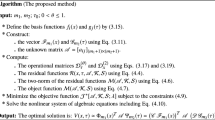Abstract
In this article, we are predicting a time-fractional-order cancer tumor growth model of brain and investigating the use of fractional derivatives as compared to integral order derivatives in space and time-dependent diffusion equations. In the brain, tumor, cancer cells grow abruptly and possibly spread to other organs and central nervous system. Treatment by medicine or therapy is required to control the tumor growth and diagnosis should be faster than tumor spread. We consider a case in which net killing rate and tumor growth are taken into account and therapy is time dependent. The fractional reduced differential transform method (RDTM) has been performed to obtain the solution of the model. It is feasible to find a closed approximate solution as well as an exact solution of fractional-order partial differential equations by using RDTM technique.
Access this chapter
Tax calculation will be finalised at checkout
Purchases are for personal use only
Similar content being viewed by others
References
Ali SM, Bokhari AH, Yousuf M, Zaman FD (2014) A spherically symmetric model for the tumor growth. J Appl Math, Article ID 726837
Benzekry S, Lamont C, Tracz A, Ebos JML, Hlatky L, Hahnfeldt P (2014) Classical mathematical model for description and prediction of experiment tumor growth. PLOS Computational biology 10(8): e 1003800
Bokhari AH, Kara AH, Zaman FD (2009) On the solutions and conservation laws of model for tumor growth in the brain. J Math Anal Appl 350:256–261
Burgess PK, Kulesa PM (1997) The interaction of growth rates and diffusion coefficients in three dimensional mathematical model of Gliomsa. J Neuropath Exp Neur 56:704–713
Cruywagen GC, Diana E, Woodward, Tracqui P, Bartoo GT, Murray JD (1995) The modeling of diffusive tumors. J BiolSyst 3(4): 937–945
Debnath L (2003) Recent applications of fractional calculus to science and engg. Hindwani Publications Corp 54:3413–3442
Hilfer R (2000) Applications of fractional calculus in physics. World Scientific, River Edge
Iomin A (2005) Super diffusion of cancer on a comb structure. J Phys: Conf Ser 7:57–67
Iyiola OS, Zaman FD (2014) A fractional diffusion equation model for cancer tumor. AIP Adv 4:107121
Jafari H, Nazarib M, Baleanuc D, Khaliquea CM (2013) A new approach for solving a system of fractional partial differential equations. J Comput Math Appl 66:838–843
Keskin Y, Oturanc G (2010) Application of reduced differential transform method for solving gas dynamic equations. Int J Contemp Math Sci 5(22):1091–1096
Kilbas, Srivastva HM (2006) Theory and applications of fractional differential equations. Elesvier 204
Laajala TD, Corander J,Saarinen M, Makela K (2012) Improved statistical modeling of tumor growth and treatment effect in preclinical animal studies with highly heterogeneous response in vivo. Clin cancer Res 18(16): 4385–4396
Marasi HR, Narayan V, Daneshbastam M (2017) A constructive approach for solving system of fractional differential equations. Wavelets Fractal Anal 3:40–47
Mohamed MS, Gapreel KA (2017) Reduced differential transform method for nonlinear integral member of Kadomtsev-Petviashvili hierchy differential equations. J Egypt Math Soc 25:1–7
Moyo S, Leach PGL (2004) Symmetry method applied to a mathematical model of a tumor of brain. Proceedings of institute of NAS of Ukrane 50(1):204–210
Oldham KB, Spanier J (1974) The fractional calculus. Academic press, Newyork
Podlubny I (1999) An introduction to fractional derivatives, fractional differential equations, some methods of their solution and some of their applications. Academic Press, San Diego-Boston-New York-London-Tokyo-Toronto. ISBN 0125588402
Rihai M, Edfawy E (2017) New method to solve fractional differential equations. Glob J 13:4735–4746
Samko SG, Kilbas AA, Marichev OI (1993) Fractional integrals and derivatives, theory and applications. Gordan and Breach Science Publishers, Langhorne, Pennsylvania
Srivastva VK, Avasthi M (2013) Solution of caputo time fractional order hyperbolic telegraph equation. AIP Adv 3:32–142
Srivastva VK, Avasthi M (2017) Solution of two and three dimensional second order time hyperbolic telegraph equations. J King Saud Univ 29:166–171
Srivastva VK, Avasthi M, Kumar S (2014) Solution of two dimensional time fractional biological population model. Egypt J of Basic Appl Sci 71–76
Tomar A, Arora R (2014) Numerical simulation of coupled Mkdv equation by reduced differential transform method. J Comput Methods Sci Eng 14:269–275
Wazwaz AM (2007) The variational iteration method for solving linear and non-linear systems of PDEs. J Comput Math Appl 54:895–902
Author information
Authors and Affiliations
Corresponding author
Editor information
Editors and Affiliations
Rights and permissions
Copyright information
© 2021 Springer Nature Singapore Pte Ltd.
About this paper
Cite this paper
Gandhi, H., Tomar, A., Singh, D. (2021). A Predicted Mathematical Cancer Tumor Growth Model of Brain and Its Analytical Solution by Reduced Differential Transform Method. In: Singh, P., Gupta, R.K., Ray, K., Bandyopadhyay, A. (eds) Proceedings of International Conference on Trends in Computational and Cognitive Engineering. Advances in Intelligent Systems and Computing, vol 1169. Springer, Singapore. https://doi.org/10.1007/978-981-15-5414-8_17
Download citation
DOI: https://doi.org/10.1007/978-981-15-5414-8_17
Published:
Publisher Name: Springer, Singapore
Print ISBN: 978-981-15-5413-1
Online ISBN: 978-981-15-5414-8
eBook Packages: Intelligent Technologies and RoboticsIntelligent Technologies and Robotics (R0)




